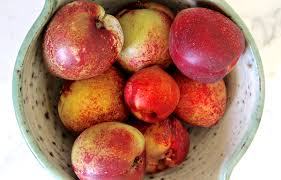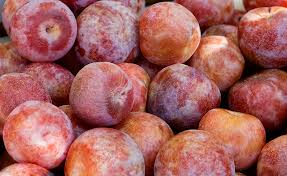
When Andrew and I plan a dinner party, the menu starts to percolate once the RSVPs have been received. We try to think of our audience and we try to make things interesting. Generally that means doing something completely new. We have a fair amount of confidence in our cooking and baking and we like to try new things. We have a group of friends who travel enough and eat out enough that they’re food adventurers. So we don’t hold back.
 To take you through the dinner menu, I’m starting with dessert. This has nothing to do with “Eat Dessert First” movement. ( Actually I had to look it up and discovered it’s a real thing based on the fact that dessert generally has some fat in it and fat serves a purpose: it helps you absorb vitamins and nutrients better.) And no, it’s not really because of the advice given in this Minute Tapioca poster from 1931. As my mother would have said “Gay used to have a very different meaning”. The reason is actually a lot simpler. Andrew has had literally dozens of requests for the exceptionally beautiful Pluot and Plumcot Tart he posted on Instagram. And a lot of people just wanted to know what on earth is a Pluot or a Plumcot. So we’ll start there.
To take you through the dinner menu, I’m starting with dessert. This has nothing to do with “Eat Dessert First” movement. ( Actually I had to look it up and discovered it’s a real thing based on the fact that dessert generally has some fat in it and fat serves a purpose: it helps you absorb vitamins and nutrients better.) And no, it’s not really because of the advice given in this Minute Tapioca poster from 1931. As my mother would have said “Gay used to have a very different meaning”. The reason is actually a lot simpler. Andrew has had literally dozens of requests for the exceptionally beautiful Pluot and Plumcot Tart he posted on Instagram. And a lot of people just wanted to know what on earth is a Pluot or a Plumcot. So we’ll start there.


Plumcots have been around for hundreds of years in regions of the world where both plums and apricots are both grown from seed. They actually occurred there naturally. They came to prominence in this country when Luther Burbank gave them their name. Burbank was an American agricultural pioneer who, during his 55-year career, developed more than 800 strains and varieties of plants. He was equally at home grown fruits, flowers, grains, grasses and vegetables. His output is staggering from the Shasta Daisy to the russet Burbank potato. And of course, naming the plumcot. The Pluot is a relatively new arrival. It’s a hybrid developed by Floyd Zaiger, a biologist whose specialty was stone fruit. His hybrid Pluot is genetically 1/4 apricot and 3/4 plum—more plum than apricot despite the loss of the “m” in its name.

For this tart, Andrew chose both plumcots and pluots. The recipe came from John Barricelli’s “The SoNo Baking Company Cookbook” (Clarkson-Potter 2010). Barricelli worked with Martha Stewart. One of his tasks was to plan Martha’s weekend entertaining. One summer she asked him to make a plum tart for a dinner party. This was the one he made. Barricelli used 8 different plums and their hybrids for the tart for a rainbow of color. Andrew’s tart was every bit as beautiful and lush. The Almond cream was a perfect foil for the juicy plums and the pastry added another layer of sweetness. Here is the recipe.
Plumcot and Pluot Tart
A luscious summer pie filled with the tart sweetness of plums, apricots and creamy-rich almond flavor

Ingredients
- For the Pâte Sucrée
- 2 cups all-purpose flour
- 1 cup (2 sticks) unsalted butter, room temperature
- ¼ cup sugar
- 1 teaspoon coarse salt
- 1 large egg
- 1 large egg yolk
- For the Almond cream
- ½ cup blanched whole almonds
- 6 tablespoons sugar
- 1 teaspoon course salt
- 6 tablespoons (3/4 stick) unsalted butter, room temperature
- 2 large eggs, room temperature
- 1½ teaspoons almond extract
- 3 tablespoons all-purpose flour
- For the Filling:
- ¾ cup apricot jam, strained
- 1¼ to 1½ pounds (6-8) ripe pluots and plumcots, halved, pitted, and cut into ½ inch wedges
- 1-2 tablespoons of sugar, for sprinkling
Directions
- Step 1 First, Prepare the Pâte Sucrée:
- Step 2 In a bowl, whisk the flour to aerate it. Set aside. In the bowl of a standing mixer fitted with a paddle attachment, beat the butter, sugar and salt on medium-high speed until light and fluffy (about three minutes), scraping the sides of the bowl halfway through. Add egg and yolk. Mix to combine. Add flour and beat until it’s absorbed.
- Step 3 Scoop about half the dough onto a sheet of plastic wrap, flatten into a disk and wrap in plastic. Repeat with other half. Refrigerate until firm, at least two hours. Use half of the dough to make the plum tart and reserve the other half wrapped in plastic wrap for another recipe. Refrigerate and use within seven days.
- Step 4 On a lightly floured surface, roll dough to a 12-inch round, about 1/8-inch thick. Fit dough into a 9-inch fluted tart pan with removable bottom
- Step 5 Trim dough so that it comes slightly above the rim of the tart pan. Press the excess dough against the sharp edge of the pan rim with the heel of your hand to cut it level with the pan. Chill until firm, about 30 minutes.
- Step 6 Next, Prepare the almond cream:
- Step 7 In a food processor, pulse almonds with sugar and salt for about 10 seconds, until finely ground. Add butter, process to blend. Add eggs, processing until blended. Scrape bowl after each addition. Add almond extract. Add flour and process until combined.
- Step 8 Set oven rack at bottom third of the oven. Preheat to 375 degrees. Line a baking sheet with a nonstick silicone baking mat.
- Step 9 Next put the tart together:
- Step 10 With an offset spatula, spread tart shell with ¼ cup of apricot jam. Then spread with almond cream. Arrange plum wedges side by side, rounded sides down, on top of the cream. Press gently to settle. Place the tart on baking sheet. Sprinkle with sugar.
- Step 11 Bake for about 40 to 45 minutes. Rotate the baking sheet about two-thirds of the way through. Crust should be cooked through and golden brown, with almond cream puffed and golden. Transfer tart pan to a wire rack. Serve with Marscapone Whipped Cream.












Thanks for the clarification of the difference between plucot and plumcot. I am sharing a recipe for Zwetschgenkuchen with Andrew. Hopefully it will become a blog post!
Hopefully indeed…